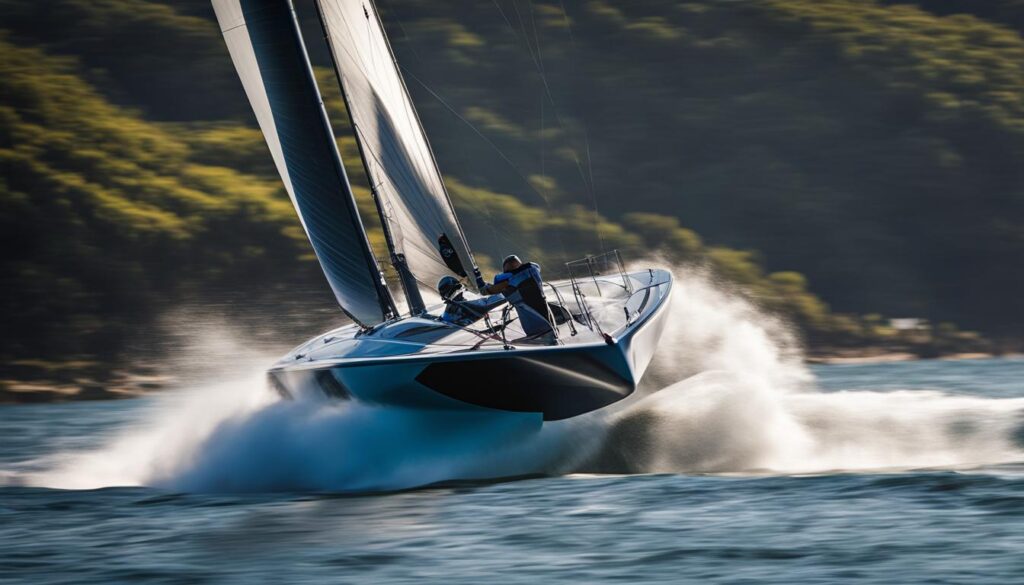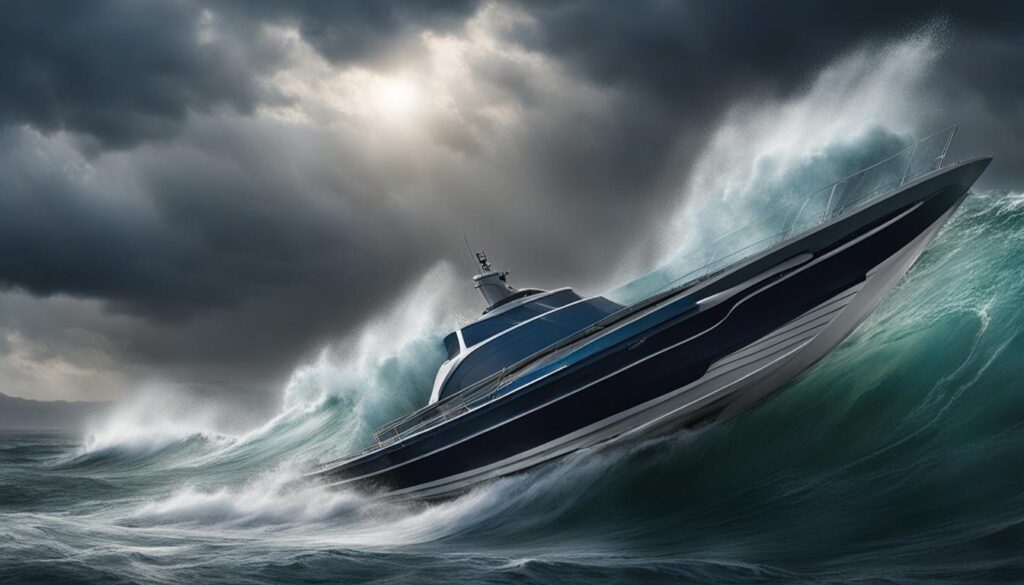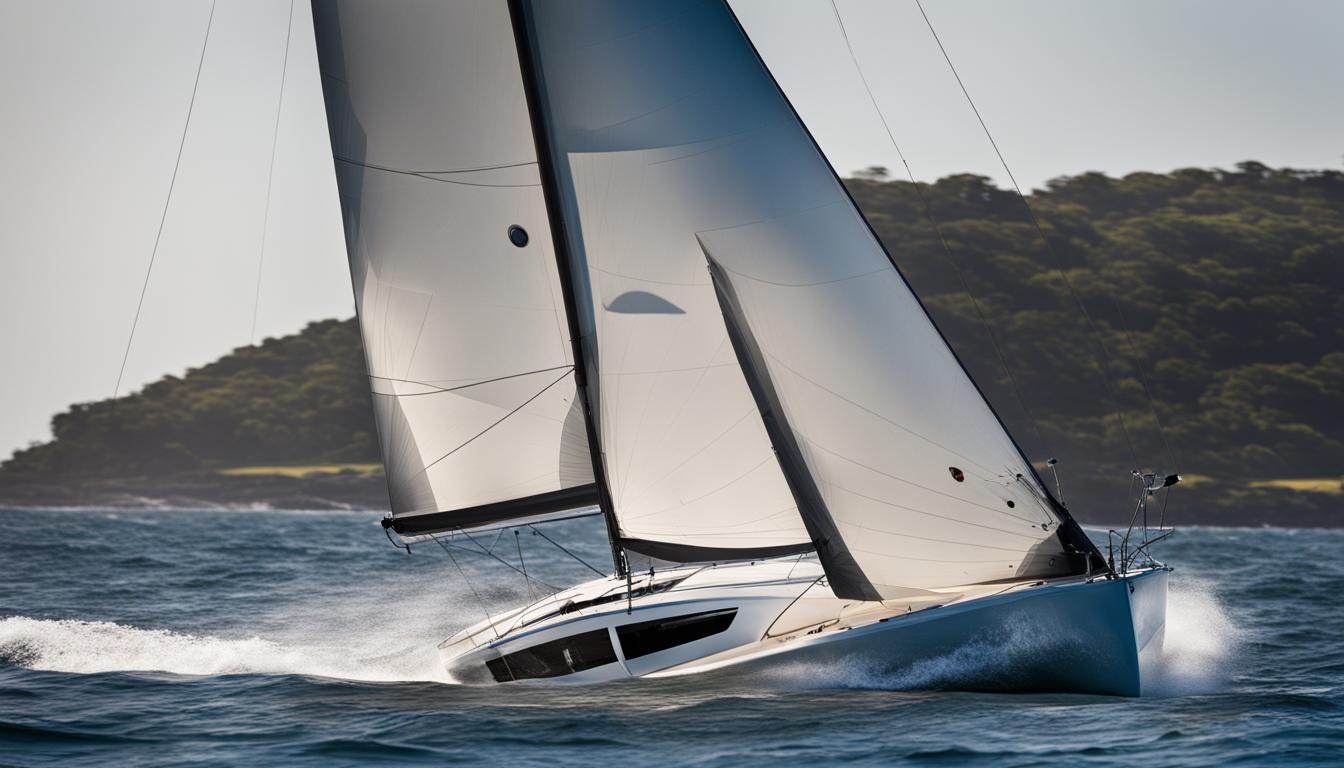When it comes to boating, one size definitely does not fit all. The water conditions you’ll encounter can vary greatly, from choppy waves to calm lakes and everything in between. That’s why it’s essential to choose the right hull shape for your specific water environment. By customizing your hull, you can ensure a smooth, stable ride and optimize your overall boating performance.
Key Takeaways:
- Consider the hull’s stability, speed, fuel efficiency, and ride comfort when selecting for different water conditions.
- Displacement hulls are rounded and provide a stable, smooth ride, but they use more fuel and are slower.
- Planing hulls lift the boat out of the water, allowing for faster speeds, but they have a rougher, more unstable ride.
- Flat-bottom hulls are stable in calm weather and have a shallow draft, while multi-hulls offer greater stability but can be less efficient.
- Deep-Vee hulls are used in wavy water and offer a good ride in rough conditions.
- Round-bottom hulls allow for easy travel at slower speeds, but can be unstable.
- Cathedral hulls provide more stability without extra width, but can result in a rough ride in choppy water.
Displacement Hulls
Displacement hulls are known for providing a stable and smooth ride in various water conditions. These hulls are rounded in shape and are designed to plow through the water rather than ride on top of it. This design feature allows displacement hulls to maintain a steady course even in rough waters, making them ideal for boaters seeking a comfortable and predictable experience.
One of the key advantages of a displacement hull is its fuel efficiency. Due to their design, displacement hulls require less power to move through the water compared to other hull types. This can result in significant fuel savings, making them a popular choice among boaters who prioritize cost-effectiveness and sustainability.
However, it’s important to note that displacement hulls are not built for speed. While they offer excellent stability and fuel efficiency, they are slower compared to planing hulls that ride on top of the water. Therefore, if speed is a priority for your boating needs, a displacement hull may not be the ideal choice.
| Advantages | Disadvantages |
|---|---|
| Stable and smooth ride | Slower speed |
| Fuel efficient |
Planing Hulls
A planing hull is a type of boat hull that is designed to ride on top of the water, rather than plowing through it like a displacement hull. These hulls are typically flat-bottomed or V-shaped in the front and flatter toward the back, allowing the boat to lift out of the water at higher speeds. Planing hulls are known for their speed and efficiency, making them a popular choice for powerboats and performance-oriented watercraft.
One of the key advantages of planing hulls is their ability to achieve faster speeds with less fuel consumption compared to displacement hulls. This is because the boat rides on top of the water, reducing friction and drag. However, this design also makes planing hulls more susceptible to a rough and unstable ride, especially in choppy or wavy conditions. The boat tends to bounce on top of waves, which can be uncomfortable for passengers.
When choosing a planing hull, it’s important to consider the intended use and the water conditions you will be navigating. While planing hulls excel in calm or moderately rough water, they may not be suitable for extremely choppy or rough seas. Additionally, the design of a planing hull may impact the boat’s maneuverability, especially at low speeds. Overall, planing hulls are a great choice for those seeking speed and efficiency, but they may sacrifice some stability and comfort in rough water.

Key Features of Planing Hulls:
- Flat-bottomed or V-shaped design for lift and speed
- Faster speeds with less fuel consumption
- Rough and unstable ride in choppy or wavy conditions
- May sacrifice stability and comfort in rough water
Flat-Bottom Hulls
When it comes to navigating calm weather and enjoying a stable ride on the water, flat-bottom hulls are an excellent choice. These hulls are typically found on smaller, open boats and are designed with a flat planing hull. The flat bottom provides stability, making them ideal for fishing in small lakes, ponds, and slow-moving rivers.
One of the key advantages of flat-bottom hulls is their shallow draft. This means that they require less water depth to operate, allowing you to explore shallow areas without worrying about getting stuck. Additionally, the stability offered by flat-bottom hulls makes them popular among anglers, providing a secure platform for casting and reeling in your catch.
It’s important to note that while flat-bottom hulls excel in calm weather, they may not be the best choice for rougher conditions. Due to their flat design, they can create a rough ride when faced with choppy water or larger waves. To compensate for this, some flat-bottom boats may have additional features such as a deep keel or stabilizers to improve stability. However, it’s still recommended to avoid venturing into rough seas with a flat-bottom hull.
| Advantages of Flat-Bottom Hulls for Calm Weather | Disadvantages of Flat-Bottom Hulls for Rough Water |
|---|---|
|
|
Overall, if you’re looking for a boat that provides stability and is suitable for calm weather conditions, a flat-bottom hull is an excellent choice. Whether you’re enjoying a leisurely day of fishing or exploring tranquil waters, the stability and shallow draft of a flat-bottom hull will enhance your boating experience.
Multi-Hull: Stability and Wide Beam
When it comes to boating, stability is a crucial factor, especially when you’re out on the water. That’s where multi-hull boats come into play. With their unique design featuring more than one hull, these vessels offer enhanced stability and balance.
The wide beam of multi-hull boats provides increased buoyancy, making them more resistant to capsizing. This aspect is particularly important when navigating rough waters or unpredictable conditions. The wider base also allows for a more spacious interior, providing ample room for passengers and cargo.
“The wide beam and multiple hulls of these boats contribute to their exceptional stability, making them an ideal choice for those seeking a safe and secure boating experience.”
Moreover, the additional stability of multi-hull boats makes them popular choices for activities such as fishing, diving, and leisure cruising. It enables anglers to cast their lines without worrying about instability, while divers can easily move around the boat without compromising safety.
So, whether you’re planning a fishing expedition or a relaxing day on the water, consider the stability and wide beam of multi-hull boats to ensure a comfortable and secure boating experience.
| Advantages of Multi-Hull Boats | Disadvantages of Multi-Hull Boats |
|---|---|
|
|
Deep-Vee Hull: Stability and a Good Ride in Wavy Water
When it comes to navigating wavy water conditions, a Deep-Vee hull is the ideal choice. Designed to handle rough seas, this hull type combines stability and a smooth ride, ensuring a comfortable experience for boaters even in challenging waters.
The Deep-Vee hull features a sharp V-shaped bottom that cuts through the waves, allowing the boat to ride over them instead of bouncing on top. This design provides superior stability and minimizes the impact of rough water, resulting in a more enjoyable journey.
Whether you’re fishing in open water or venturing farther offshore, a Deep-Vee hull offers excellent maneuverability at slow speeds, making it easier to navigate through turbulent waters. Its shallow draft also makes it suitable for fishing in small lakes and rivers.
The Benefits of a Deep-Vee Hull:
- Superior stability in wavy water conditions
- Smooth ride, minimizing the impact of rough seas
- Easy maneuverability at slow speeds
- Shallow draft for fishing in small lakes and rivers
When selecting a boat or kayak for wavy water conditions, consider the Deep-Vee hull for its stability, good ride, and overall performance. It’s the perfect choice for those seeking an adventure on the open water.
Round-Bottom Hull
A round-bottom hull is a type of hull design that features a rounded shape, allowing for easy travel through water at slower speeds. These hulls are commonly found in dinghies, tenders, and some car-top boats. They offer certain advantages, such as maneuverability and ease of handling in calm conditions. However, it’s important to note that smaller boats with rounded hulls can be very unstable and have a tendency to roll unless they have additional stabilizing features like a deep keel or stabilizers.
The rounded shape of a round-bottom hull can make it prone to rolling, especially when subjected to waves or choppy waters. This instability can create a less comfortable and potentially dangerous boating experience. Therefore, it’s crucial to consider the specific water conditions you’ll be navigating and assess whether a round-bottom hull is suitable for your needs.
When using a boat with a round-bottom hull, it’s important to maintain proper balance and weight distribution to minimize the risk of rolling. Additionally, employing techniques such as keeping a lower center of gravity and avoiding sudden movements can help mitigate the instability associated with this type of hull design.

Comparison of Hull Types
| Hull Type | Advantages | Disadvantages |
|---|---|---|
| Round-Bottom | Easy travel at slower speeds | Prone to rolling and instability |
| Displacement | Stable and smooth ride | Requires more fuel and slower speeds |
| Planing | Fast speeds and fuel efficiency | Rough and unstable ride |
| Flat-Bottom | Stability in calm weather and shallow draft | Can create a rough ride |
| Multi-Hull | Greater stability | Propeller holding issues with planing hulls |
| Deep-Vee | Good ride in rough water and stability | Requires more power and may roll in sharp turns |
When choosing a hull type for your boat or kayak, it’s essential to consider the specific water conditions you’ll be encountering. While round-bottom hulls offer ease of travel at slower speeds, they come with the trade-off of potential instability and rolling. So, it’s important to weigh the advantages and disadvantages of each hull type and make an informed decision based on your boating preferences and safety considerations.
Conclusion
When it comes to selecting hull shapes for different water conditions, you have a wide range of options to consider. Whether you’re planning on kayaking in the ocean, exploring calm lakes, or navigating challenging river conditions, choosing the right hull design is crucial for optimizing your boating experience.
For ocean kayaking, hull shape variations are important to ensure stability and maneuverability in rough seas. Deep-Vee hulls are a popular choice, as they offer a good ride in wavy water and allow for easy maneuvering at slow speeds.
If you’re planning on kayaking in lakes, selecting hull designs that prioritize stability and efficiency is key. Flat-bottom hulls are suitable for calm water navigation, providing stability and a shallow draft. They are great for fishing in small lakes and slow-moving rivers.
When navigating river conditions, hull design considerations should prioritize agility. Tailoring kayak hulls to diverse water environments is essential for maneuvering around obstacles and maintaining control. Look for hull shapes optimized for challenging waters to ensure a smooth and enjoyable experience.
Remember, the hull shape you choose can greatly impact your boating performance. By understanding the characteristics of different hull designs and tailoring them to your specific water environment, you can optimize your kayaking experience and make the most of your time on the water.
FAQ
What are the different types of boat hulls suitable for different water conditions?
The different types of boat hulls suitable for different water conditions include displacement hulls, planing hulls, flat-bottom hulls, multi-hull boats, deep-Vee hulls, round-bottom hulls, and cathedral hulls.
What are displacement hulls?
Displacement hulls are rounded and plow through the water, providing a stable and smooth ride. However, they require more fuel to move through the water and are slower compared to other hull types.
What are planing hulls?
Planing hulls are either flat-bottomed or V-shaped in front and flatter toward the back. They ride on top of the water, which allows them to go faster and use less fuel compared to displacement hulls. However, they have a rougher and more unstable ride because they bounce on top of waves.
What are flat-bottom hulls?
Flat-bottom hulls are typically found on smaller, open boats and have a flat planing hull. They provide stability in calm weather and have a shallow draft, making them suitable for fishing in small lakes, ponds, and slow-moving rivers. However, they can create a rough ride and require more power to move at the same speed as flat bottom hulls.
What are multi-hull boats?
Multi-hull boats have more than one hull and provide greater stability. They often use two hulls for added stability and easier travel through the water. However, propellers on boats with planing hulls may not be fully submerged, leading to holding issues and the need for higher pitch and rake.
What are deep-Vee hulls?
Deep-Vee hulls are used in wavy water or when going farther offshore. They offer a good ride in rough water and are easier to maneuver at slow speeds. Deep-Vee hulls have a shallow draft and are suitable for fishing in small lakes and rivers. However, they require more power to move at the same speed as flat bottom hulls and may roll or bank in sharp turns.
What are round-bottom hulls?
Round-bottom hulls are mostly displacement hulls and are used for dinghies, tenders, and some car-top boats. They have a rounded hull that allows for easy travel through water at slower speeds. However, smaller boats with rounded hulls can be very unstable and have a tendency to roll unless they have a deep keel or stabilizers.
What should I consider when selecting hull shapes for different water conditions?
When selecting hull shapes for different water conditions, it’s important to consider factors such as stability, speed, fuel efficiency, and ride comfort. The type of hull you choose can greatly impact your boating experience, whether you’re kayaking in the ocean, navigating calm lakes, or tackling challenging river conditions. By understanding the characteristics of different hull shapes, you can customize your boat or kayak to suit your specific water environment and optimize your overall boating performance.





